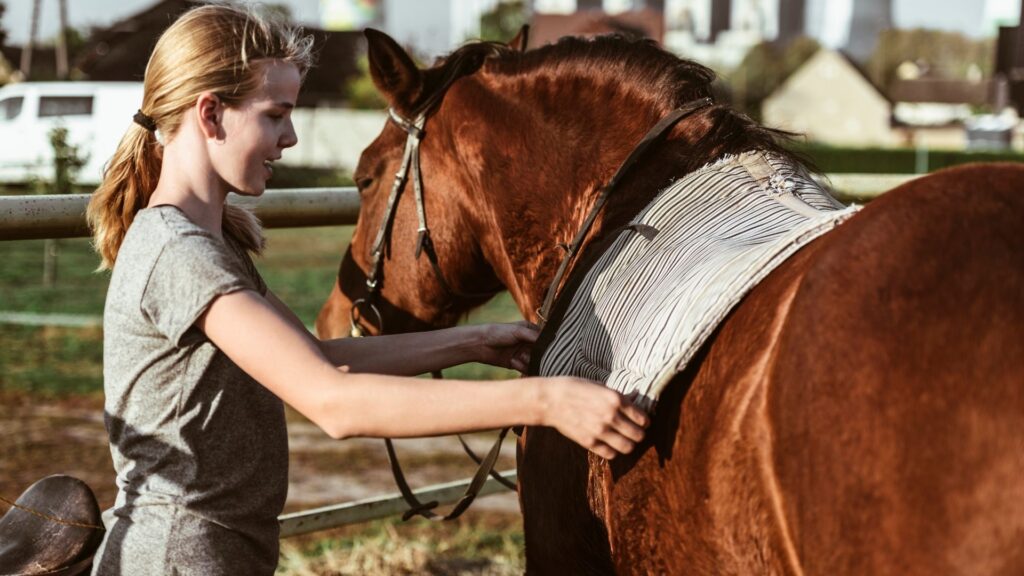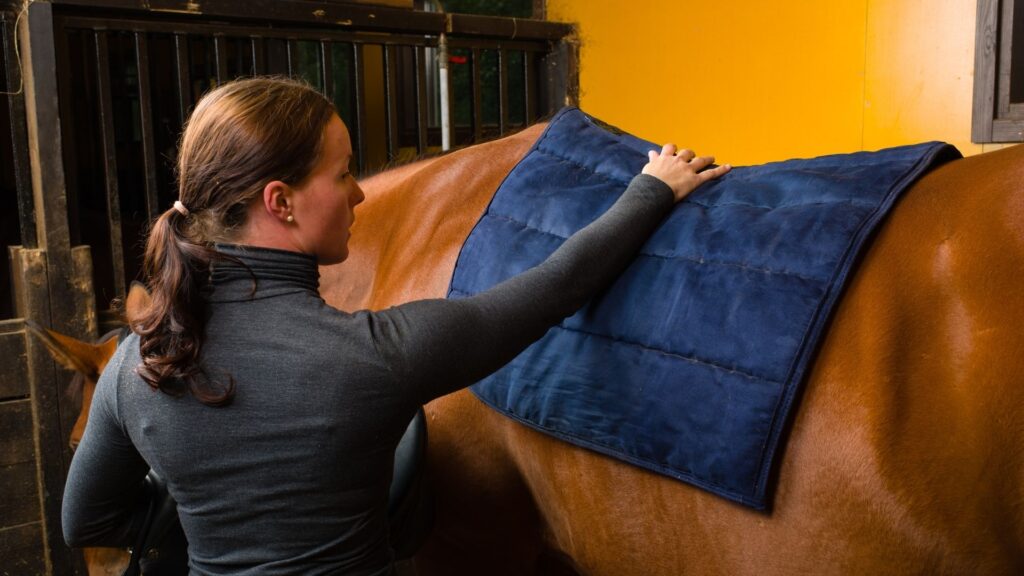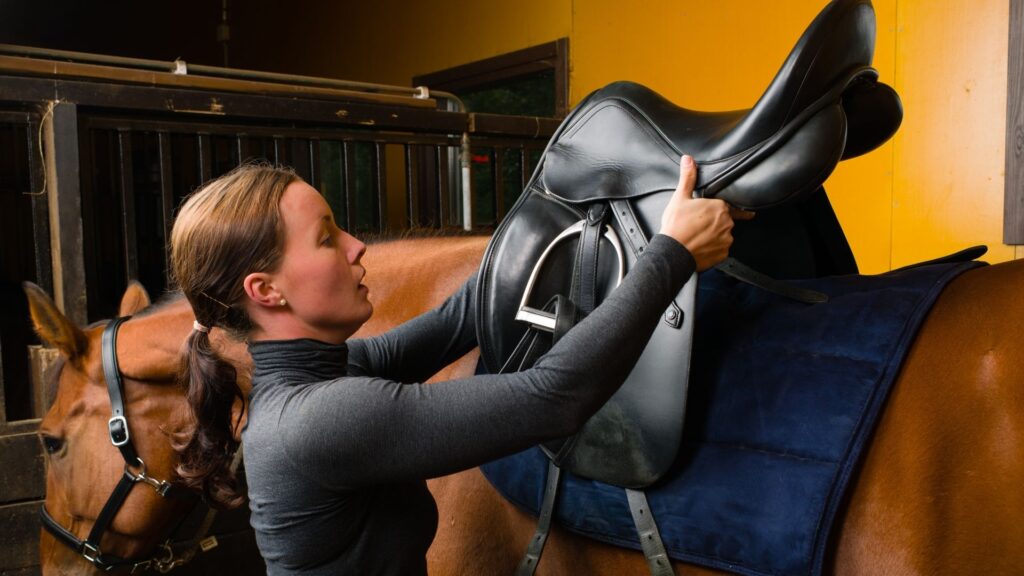Last updated: August 29, 2021
If your horse is ready for saddle training, that means you’ve established your leadership role, bonded with the horse, and taught it a few things through regular groundwork. You’ve accomplished a lot, and now it is time to start saddle training.
To saddle train a horse, you should be patient and progress in steps. First, get them used to carrying something on its back and add some weight; then make sure they’re comfortable with the girth before finally putting it all together by adding the saddle.
Saddle training your horse is an exciting and intimate time where you get to bond and teach your animal something new. And while you may be anxious to start, there are a few things your horse must learn before they’ll be ready to begin saddle training.

This article is part 3 of a series I wrote on horse training. The first article is in the series is an easy-to-follow guide: Horse Training: Step by Step Guide for Beginners.
Basic Training For Your Horse
Young horses should learn the basics, such as listening to you by performing lead exercises and teaching them how to be comfortable with touch.
You should train them to follow directions through lunging work and continue training until they show signs that they’re ready to start saddle training. Groundwork is an essential key to preparing your young horse for saddle training.
Before starting any training, it’s essential to make sure that your horse is at least two years of age. At this age, the horses are physically mature enough to learn and train.
Training a horse to ride too young can result in horses facing physical problems such as joint pains and bone spurs. If you are uncertain if your horse is mature enough to ride, make sure to consult with a veterinarian or trainer for their guidance.
Groundwork exercises
Once you establish your horse is physically ready, you should teach them some groundwork exercises such as
listening by leading them on a halter and rope. If you’re not sure of what this means, it means that you would walk in front of the horse with the rope, or you can also walk near its shoulder, otherwise known as the ” partner position.”
This exercise allows for the pressure applied to the lead to be felt more clearly by the horse. It teaches the horse how to respect your space and how to adjust according to your cues. Keep in mind that each horse will learn at its own pace, so training can take anywhere from weeks to months to successfully train your horse.
Another tool that you can include in the groundwork training is a Lunge whip. Never use this tool to inflict harm, but rather, you can use it to point it or wave it as needed. While there is an abundance of groundwork exercises that you can practice with your horse, some of the best ones are:
- Teaching them to stand still.
- Teach your horse to flex and soften to pressure.
- Teach them to work on a lunge line in a circle
- Train them to move the front-end and hind-end.
These different training exercises are an excellent way to introduce new tasks to your equestrian pal while instilling mutual respect between you and the horse and solidifies your role as the leader and authority figure in your two-member herd.
You can do this sort of training daily for up to thirty minutes per day. On that note, please be patient with your young horse as they learn these new techniques to allow them to learn things properly.
Teaching your horse some groundwork exercises is essential, and it’s a tool that every equestrian should adopt in their training regimens. Not only does it allow your horse to respect you as an authority figure, but it helps build your relationship with your beloved animal.
Touch exercises
A great way to teach your horse how to feel comfortable with touch is by practicing touch exercises. It allows the horses to accept and feel comfortable when you approach to touch them. Since horses wear riding gear on their faces and backs, this exercise helps them feel accustomed to the feeling.
You can do things such as touch them with your hands or a piece of cloth to feel safe and calm, which will help build a bond between you and your equestrian buddy. Grooming can also be a way of rewarding your horse when it achieves its goal.
Saddle training step by step
1. Saddle blanket training.
The best way to ensure that the horse will know how to remain calm when strapping on its saddle is by practicing the saddle blanket technique.

Saddle blankets/pads are the fabric you place under the saddle equipment that absorbs their sweat, protects their backs, and cushions the saddle.
They come in different thicknesses and other fabrics, and some folks use them for decorative purposes. Saddle blankets are great for getting your horse used to feeling the equipment on its back, and it allows them to get used to having the extra weight as well.
You can let the horse sniff the blanket before placing it on their backs so they can feel familiar with the material
before having it on.
2. Introduce the girth.
The girth is an essential part of the horse’s saddle; the broad strap goes around the horse, securing the saddle on the horse’s back.

The material is typically leather or cotton, and without the girth, the saddle would be of little to no use. I suggest using a training surcingle to help your horse start feeling accustomed to the girth; this strap is similar to a girth that wraps around a horse.
Put the equipment on them gently to avoid startling or making them feel anxious about what’s taking place. Place the surcingle gently on its back, lowering it on its right side.
Don’t tighten it right away; let the horse get used to breathing with the equipment a couple of times before tightening it up. You can massage around the girth area and watch for any adverse reactions that the horse might show.
Once you feel ready to proceed with the mock girth, and your horse is not showing any signs of the girth bothering them, then you wait for the moment that your horse breathes out to tighten the holes one at a time.
Allow your horse to work in freedom again by loosening the surcingle to let them get accustomed to the pad and allow for them to let their tension out through moving.
Allow the horse to run around with the surcingle tightened to get used to the feeling and use positive reinforcement so they can feel at ease with the equipment.
You can repeat these steps as needed as this teaches the horse to stand still and feel calm while they feel pressure instead of feeling anxious and walking away. You can also let the mock girth dangle against its legs so that they don’t feel scared if this ever occurs to them.
3. Saddle your horse.
When you put a saddle on your horse, it’s a good practice to remove or raise the stirrups, so they don’t swing and distract your horse.

At this point, the horse should already be familiar with having equipment on its back so it won’t feel alarmed.
Since you would typically mount the horse on its left side, it’s a good idea to approach it on that same side when placing the saddle.
A good way of making sure that your horse does not feel alarmed by the saddle is to rub it with the saddle pad before placing it down on its back and place it down gently without tightening anything on for a couple of minutes to see the horse’s reaction.
You can use a mounting block to facilitate the process of placing the saddle on the horse. You can allow the horse to feel your weight by standing on the block and pushing down as you lean with your hands to apply the pressure.
The horse might start to move the first couple of tries, so it’s best to keep practicing until the horse gets comfortable with the process. Once the horse is calm and standing still, you’re ready to mount your horse, sitting still before
dismounting.
Knowing how to mount correctly will allow the horse to get used to the sensation of the saddle on its back. You can do this exercise in ten-minute intervals, which helps the horse to get accustomed to being mounted and dismounted.
Your horse will get used to the extra weight of the saddle and of you riding its back as well. You can try remaining on the saddle for a fraction of minutes without moving so that the horse can build its strength and prevent injuries to its muscles and joints.
Once you feel your horse is ready to take a step farther in saddle training, you begin to walk your horse while in the saddle. The easiest way to start this is by gently squeezing your horse with your legs so that it can start walking.
If the horse is not moving, you can gently tap it by using your heels. You’ll know once the horse is ready to walk with the saddle when it does not show signs of fear or anxiety when mounted or saddled.
And, please keep in mind that horses learn through repetition, so be patient with these lovely creatures as they grasp how to form a bond and trust you as their owner. Your horse is just as nervous as you are and deserve all the love and kindness needed to ensure successful training.
The critical point is to make a bond before trying to rush your horse to do anything, as, without trust, they won’t be able to learn new tasks or trust you in the process.
FAQ
What age should a horse be started under saddle?
Many horses can start training under the saddle at two years old. But it depends on the breed and how the horse matures. If a horse is started too young, it can get hurt, so always have a young horse vet checked before you start putting weight on its back.
How long does it take for a horse to get used to a new saddle?
A horse generally gets used to a new saddle relatively quickly. It just depends on the saddle style, quality, and what you were riding your horse with before switching saddles.
Resources
- Basic Training of the Young Horse: Dressage, Jumping, Cross-country
- Should equine athletes commence training during skeletal development?: changes in tendon matrix associated with development, ageing, function and exercise

About the Author: Miles Henry
Lifelong Horseman | Racehorse Owner | Published Author
Miles Henry brings over 25 years of hands-on experience training and owning Thoroughbred racehorses. Raised with Quarter Horses and Appaloosas, he’s spent a lifetime learning from horses—on the track, in the barn, and in the field. Today, he runs a small but successful racing stable in Louisiana and shares real-world insights on HorseRacingSense.com, helping horse owners, fans, and bettors navigate the sport with confidence.
📚 Books: View Miles’s books on Amazon »
🎧 Podcast Guest: Animal Tales Ep. 32 |
YouTube Interview
📩 Newsletter: Sign up for racing tips and horse care advice »
🔗 Follow Miles:
Twitter |
Facebook |
YouTube

